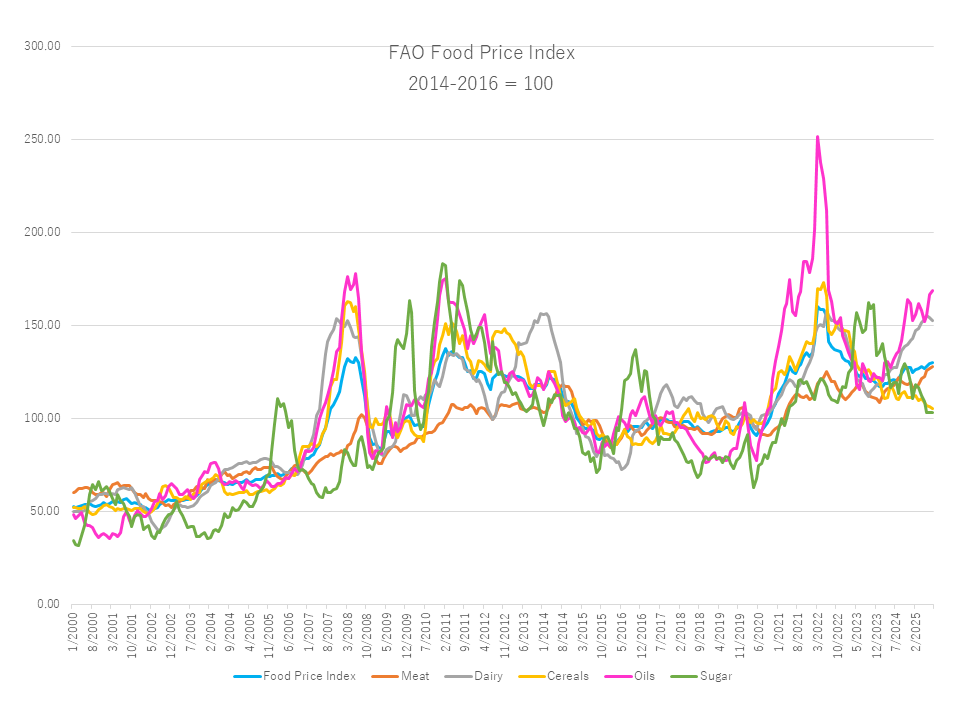Pick Up
1335. World Food Price Trends, August 2025

1335. World Food Price Trends, August 2025
The Food and Agriculture Organization of the United Nations (FAO) released its World Food Price Trends report on September 5. The average for August 2025 was 130.1 points, roughly unchanged from July. Declines in the cereal and dairy price indexes were offset by increases in the meat, sugar, and vegetable oil indexes. Overall, the food price index increased 6.9% from August 2024 last year, but remained 18.8% below its peak in March 2022.
The FAO Cereal Price Index decreased 0.8% from July and 4.1% from August 2024. International wheat prices fell month-on-month, reflecting a global oversupply and weak import demand, particularly from major importing countries in Asia and North Africa. Increased harvests in the European Union and the Russian Federation further depressed prices. Meanwhile, world corn prices increased for the third consecutive month, supported primarily by concerns about the impact of heatwaves on yields in the European Union and increased demand for animal feed and ethanol production, particularly in the United States. Meanwhile, the FAO All Rice Price Index fell 2.0% month-on-month due to a decline in Indica rice prices amid continued fierce competition among exporters.
The FAO Vegetable Oil Price Index rose 1.4% month-on-month, reaching its highest level since July 2022. This increase was driven by higher palm oil, sunflower oil, and rapeseed oil prices, which more than offset a slight decline in soybean oil prices. International palm oil prices rose for the third consecutive month through August, primarily supported by strong global import demand and Indonesia's intention to further increase biodiesel blending mandates in 2026. Global sunflower oil and rapeseed oil prices rose due to tighter supplies in the Black Sea region and Europe, respectively. Meanwhile, global soybean oil prices fell slightly, mainly reflecting the outlook for abundant global soybean supplies in the 2025/26 season.
The FAO Meat Price Index rose 0.6% month-on-month and 4.9% year-on-year to a new record high. The increase was driven by continued increases in beef and lamb prices, outweighing a generally flat pork market and a decline in chicken prices. International beef prices reached a new record high, supported by strong demand from the United States, which boosted Australian beef prices, and solid import demand from China, which held Brazilian export prices steady despite a decline in sales to the United States following the implementation of additional tariffs. Lamb prices rose for the fifth consecutive month, reflecting tighter export supplies in Oceania, which led to increased exports to more lucrative markets, particularly the United Kingdom of Great Britain and Northern Ireland (UK) and the United States. World pork prices remained broadly stable amid a balanced global supply and demand environment. Meanwhile, chicken prices declined, pressured by abundant export supplies from Brazil. While Brazil declared its commercial poultry farms free of highly pathogenic avian influenza in mid-June, continued import restrictions by some major trading partners continue to affect demand.
The FAO Dairy Price Index fell 1.3% in August 2025 from July, marking the second consecutive month of declines, but was still up 16.2% year-on-year.
After five consecutive months of declines, the FAO Sugar Price Index rose slightly by 0.3 points (0.2%), reflecting concerns about Brazil's production outlook, but remained 9.0% lower year-on-year.
Contributor: IIYAMA Miyuki, Information Program
